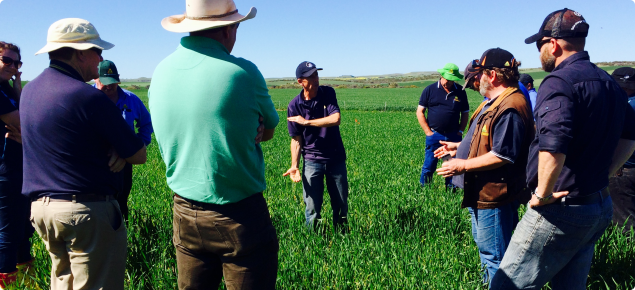In 2015 there were a lot of reports of powdery mildew in wheat across the northern and central wheatbelt and around Esperance. It was also an issue for wheat growers in 2016 in several areas of the northern and central wheatbelt. Prior to this it had not been an issue in WA wheat crops for more than 15 years.
Powdery mildew has a short infection cycle and produces millions of spores so can develop rapidly in the crop. Humid, mild weather and a damp canopy favour development of the disease. Rain is not required for disease spread but does encourage canopy humidity. Crops at the greatest risk from powdery mildew infection are those that are rated moderately susceptible to susceptible, or lower particularly those with dense canopies, high nitrogen status or good soil moisture profile which promotes canopy humidity. For more information refer to Wheat disease ratings.
Control strategies and trial results
Fungicides can reduce disease severity but yield responses are variable, from no response to around 15%, from a single spray. If the disease is present and increasing in the canopy and weather conditions are favourable, it is recommended growers intervene in susceptible varieties to stop disease reaching damaging levels and moving onto the flag leaf and head. The key to remember is that fungicides are more efficient as protectants than eradicants, so applying them before the disease becomes severe is important for management. Fungicides can struggle to manage disease once it has become rampant in a crop. However, weather conditions are key to powdery mildew development, if the outlook is for hot drying conditions, it is likely that disease will diminish quickly reducing the need for fungicide.
All fungicides registered for powdery mildew control in cereals should provide significant protection. For more information refer to Registered foliar fungicides for cereals in Western Australia.
Trials conducted in 1990s and early 2000s
Historical Department of Agriculture and Food, Western Australia (DAFWA) trials with propiconazole, tebuconazole and triadimefon have given yield responses in wheat (Table 1). In DAFWA trials where mildew was the dominant disease, yield responses were not guaranteed. Where responses occurred from a single spray application the yield response ranged from <5% to 15-17% (when fungicide was applied from flag leaf to head emergence). Greater responses can occur where powdery mildew is present with other diseases. In trials where disease established earlier (stem extension) and two sprays were applied, responses up to 20% were recorded.
| - | Application rate | Regans Ford* 1999 | Wagin* 1998 | Dunn Rock* 1999 | Munglinup* 2001 | Munglinup# 2001 | Gibson* 2002 |
|---|---|---|---|---|---|---|---|
| Sprayed growth stage | - | Z41 | Z31 | Z41 | Z59 | Z49 | Z39 |
| Yield (t/ha) untreated | - | 2.3 | 2.6 | 1.7 | 2.8 | 2.75 | 2.0 |
| Triad | 125g ai | 6% | 7% | 7% | 15% | 7% | 1 |
| Folicur | 290ml | 5% | - | 15% | - | 8% | - |
| Tilt | 250ml | - | 6% | - | 15% | 10% | 9% |
| Tilt | 500ml | - | - | - | 17% | - | 9% |
| Full control | Three spray | - | 13% | - | - | - | 8% |
| Mildew specific | Two spray | 4% | 17% | 7% | 17% | - | - |
| LSD | - | ns | 12% | ns | 11% | 7% | ns |
* DAFWA trial (Jayasena, Loughman)
# Landmark trial
Recent trial work
Foliar fungicides
A collaborative effort between DAFWA and industry partners allowed trial results from all over the wheatbelt in 2015 to be combined into a research paper for the 2016 GRDC Grains Research Updates. This paper which includes all the results can be viewed on the GIWA website. The key messages from this research were:
- Application of a single foliar fungicide spray at a registered rate to a susceptible variety gave a significant yield response in four out of six trials, when powdery mildew infection occurred from stem extension onwards. Average yield response across all trials to a single fungicide spray was 8%. Timing of application (as soon as possible after disease observed moving up canopy) was more important than product choice.
- The best timing was: 1) before disease became severe and before flag leaves and particularly heads were infected and 2) where disease onset was later, once all leaves had emerged (that is, after Z39) so maximum canopy area was protected.
- An earlier sown crop was more vulnerable to head infection than a later sown crop alongside it.
- Fungicide application after head emergence was too late to provide effective head protection and was not economic.
At seeding fungicides
In 2016, DAFWA conducted trials in Geraldton, Dalwallinu, Moora and Tambellup to evaluate the efficacy of seed and fertiliser applied fungicide for powdery mildew in wheat. There are currently no seed dressings or in-furrow fungicides registered for wheat powdery mildew control. The report on this trialwork can be viewed on the GIWA website. The key messages from this research were:
- In four field experiments in at-risk environments in 2016, wheat powdery mildew was evident at three sites and reached yield limiting severity at one site. At two sites where powdery mildew infection commenced during stem elongation, seed dressings containing fluquinconazole, triadimenol or fluxapyroxad and in-furrow products containing flutriafol, triadimefon or azoxystrobin had significant impact on disease severity and incidence. Product differences were evident between sites.
- At the one site where powdery mildew was yield limiting, in-furrow and foliar fungicide treatments gave a significant yield response (13-26%) in a susceptible wheat variety.
- In three of four sites where disease severity was not yield limiting, neither foliar, seed dressing or in-furrow fungicides provided a yield response and would not have given positive return on investment. This is a reminder that in the absence of disease, at seeding fungicides are unlikely to provide yield or economic benefit.
Fungicide resistance testing
It is always important to follow good resistance management strategies by treating crops before the disease becomes severe, rotating fungicides and not using more than two sprays of any product per season. Difficulties in controlling the disease observed in the field are most likely related to high inoculum pressure, suitability of weather for infection, variety susceptibility, poor canopy penetration, inadequate fungicide rate or use of an outdated product. If however you suspect fungicide resistance is occuring in your crop, you can send diseased leaf samples for fungicide resistance testing, contact the Fungicide Resistance Group at the Centre for Crop and Disease Management, Curtin University on +61 (0)8 9266 3061 to obtain a sample submission tube.
Further reading
For further reading refer to Managing powdery mildew in wheat, Diagnosing powdery mildew in cereals and Registered foliar fungicides for cereals in Western Australia.



